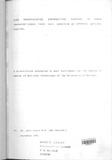| dc.contributor.author | Butt, F | |
| dc.contributor.author | Chindia, M | |
| dc.contributor.author | Kenyanya, T | |
| dc.contributor.author | Gathece Loice W. | |
| dc.contributor.author | Rana, F | |
| dc.date.accessioned | 2013-04-29T11:02:03Z | |
| dc.date.available | 2013-04-29T11:02:03Z | |
| dc.date.issued | 2010 | |
| dc.identifier.citation | J Oral Maxillofac Pathol. 2010 Jan;14(1):33-5. | en |
| dc.identifier.uri | http://www.ncbi.nlm.nih.gov/pubmed/21180457 | |
| dc.identifier.uri | http://erepository.uonbi.ac.ke:8080/xmlui/handle/123456789/17646 | |
| dc.description.abstract | Currently, published literature has increasingly projected the ranula as a lesion that may be closely associated with exposure to the human immunodeficiency virus (HIV). In this report, we document 28 patients who presented with ranulae, among whom 19 were HIV infected. In some, this was the only lesion that was the sentinel sign of HIV infection. Most probably, this lesion could be considered as one of the clinical markers of this infection | en |
| dc.language.iso | en | en |
| dc.subject | Human immunodeficiency virus infection | en |
| dc.subject | Ranula | en |
| dc.subject | Periductal lymphocytosis | en |
| dc.title | An audit of ranulae occurring with the human immunodeficiency virus infecton. | en |
| dc.type | Article | en |
| local.publisher | Departments of Oral & Maxillofacial Surgery, University of Nairobi, Kenya | en |
| local.publisher | Department of Periodontology, Community and Preventive Dentistry, Nairobi, Kenya | en |
| local.publisher | Department of Dentistry, Kenyatta National Hospital, Nairobi, Keny | en |
| local.publisher | Department of Pathology, Aga Khan University Hospital, Nairobi, Kenya | en |

